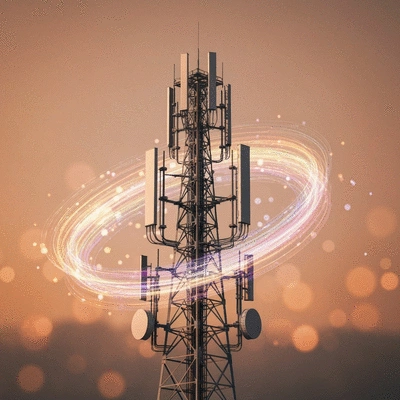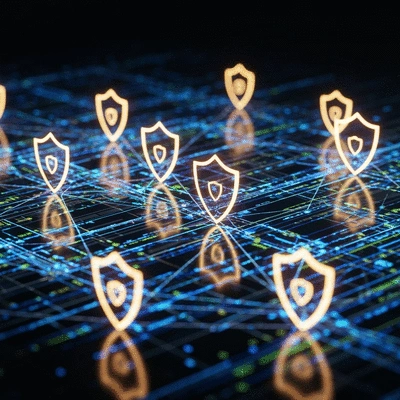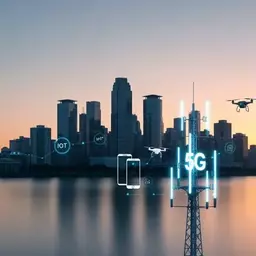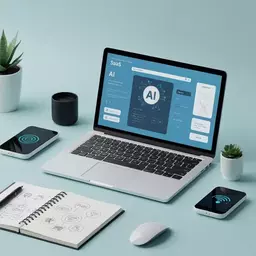What if the key to transforming industries lies not in a new gadget, but in a revolutionary network technology? The expansion of 5G is set to redefine connectivity and catalyze innovations across diverse sectors.
What You Will Learn
- 5G technology offers speeds up to 100 times faster than 4G, enabling unprecedented connectivity.
- Key features of 5G include ultra-reliable low latency communications (URLLC), essential for critical applications like remote surgeries.
- The integration of 5G with AI and AR/VR technologies will enhance training programs and customer experiences significantly.
- 5G is pivotal for sectors such as healthcare, logistics, and manufacturing, facilitating real-time data sharing and improving operational efficiency.
- Cybersecurity remains a top concern with 5G deployment, necessitating robust security protocols and strategies for businesses.
- Regulations will shape the trajectory of 5G technology, impacting deployment and service provider compliance on a global scale.
5G vs. 4G: A Comparative Overview of Key Features
The table below highlights the significant advancements 5G technology brings over its predecessor, 4G, in terms of speed, latency, and device capacity.
Speed
4G
100 Mbps
5G
10 Gbps
5G offers up to 100 times faster speeds.
Latency
4G
30-50 ms
5G
1 ms
Near instantaneous response times with 5G.
Device Capacity
4G
2,000 devices/km²
5G
1 million devices/km²
Vastly increased capacity for connected devices.
Impact on Industries
- Healthcare: Telemedicine, real-time diagnostics.
- Manufacturing: Supply chain, operational efficiency.
- Logistics: Automation, tracking.
Transforming sectors with smarter solutions.
Understanding the Impact of 5G Expansion on Technology Industries
The expansion of 5G technology is a hot topic right now, and it’s easy to see why. This new generation of mobile connectivity is not just about faster internet speeds; it’s about opening doors to innovations that can transform entire industries. As a tech enthusiast, I've been closely following these developments, and I can tell you that 5G is going to change the game! For more insights into emerging technologies, consider reading about AI Technologies to Watch in 2025.
In this section, we'll explore what 5G technology really is and why it matters. We’ll also look at how its implementation is shaping digital transformation across various sectors. Let’s dig in!
What is 5G Technology and Why It Matters
At its core, 5G technology represents the fifth generation of mobile networks, designed to enhance connectivity and data transmission. But what does that mean for us? Simply put, 5G enables faster speeds, lower latency, and greater capacity compared to its predecessors. This means smoother connections and the ability to support a massive number of devices simultaneously!
- Faster Speeds: Up to 100 times faster than 4G!
- Reduced Latency: Nearly instantaneous response times, crucial for real-time applications.
- Higher Capacity: Ability to connect more devices without sacrificing performance.
These features are not just technical jargon; they have real-world implications for industries across the board. With 5G, we're not just discussing improved mobile browsing; we're talking about revolutionary changes in how businesses operate.

Defining 5G: Key Features and Advantages
So, what are the key features that set 5G apart? Let’s outline a few:
- Massive Machine-Type Communications: Ideal for IoT devices.
- Ultra-Reliable Low Latency Communications (URLLC): Perfect for critical applications like remote surgery.
- Enhanced Mobile Broadband (eMBB): Supports high-bandwidth applications like AR and VR.
These advantages mean 5G can significantly impact sectors such as healthcare, manufacturing, and entertainment by enabling smarter solutions. Picture smart hospitals with real-time data sharing or factories that can monitor machinery in real time without lag!
Comparison to Previous Generations: 4G vs. 5G
When we compare 4G and 5G, the differences become clear:
| Feature | 4G | 5G |
|---|---|---|
| Speed | Up to 100 Mbps | Up to 10 Gbps |
| Latency | 30-50 ms | 1 ms |
| Device Capacity | 2,000 devices/km² | 1 million devices/km² |
This comparison shows just how much faster and more effective 5G is in addressing the needs of today’s connected world. As we embrace this technology, we can look forward to innovations that were previously unimaginable!
How 5G is Shaping Digital Transformation Across Sectors
Now that we've covered what 5G is and why it's essential, let’s dive into how it’s shaping digital transformation across multiple sectors. The implications are vast, and industries are already starting to adapt.
- Healthcare: Enabling telemedicine and real-time diagnostics.
- Manufacturing: Revolutionizing supply chain management and operational efficiency.
- Logistics: Improving automation and tracking capabilities.
By understanding the role of 5G in these areas, we can better appreciate its potential to innovate and enhance lives globally. Join me as we explore each sector's unique contributions and transformations driven by this exciting new technology!
The Role of 5G in Enabling IoT and Smart Devices
One of the most exciting aspects of 5G is its role in enabling the Internet of Things (IoT). With increased connectivity, smart devices can interact in ways we never thought possible. Imagine a world where your refrigerator can communicate with your grocery store to replenish items or your car alerts you about traffic in real-time. This is the future that 5G is making possible! This kind of interconnectedness is also crucial for AI SaaS Startup Ideas for 2025.
The potential for innovation is enormous, but it also comes with challenges. For instance, how do we ensure the security of all these interconnected devices? It’s a question that industry leaders are tackling as we move forward.
5G Integration with AI and AR/VR Technologies
5G’s high-speed capabilities are also enabling advancements in artificial intelligence (AI) and augmented/virtual reality (AR/VR). The combination of these technologies can create immersive experiences like never before. For instance, think about virtual reality training programs that leverage 5G for real-time feedback or AI-driven analytics that help businesses streamline operations.
- Enhanced Training Programs: VR experiences powered by 5G.
- Real-Time Analytics: AI systems that analyze big data instantaneously.
- Improved Customer Experiences: Tailored interactions through smart devices.
As 5G technology continues to expand, it’s clear that the integration with AI and AR/VR will redefine how industries operate and engage with consumers.
The Contribution of Cloud Computing and Edge Computing to 5G Applications
Finally, let’s discuss how cloud computing and edge computing are complementing 5G advancements. With the increase in data generated by connected devices, it’s essential to process that data efficiently. Edge computing allows data to be processed closer to where it's generated, reducing latency and improving response times.
This synergy between 5G, cloud, and edge computing is paving the way for applications that can respond in real time. By leveraging these technologies together, businesses can enhance their operational capabilities and unlock new opportunities for growth.
Pro Tip
As you explore the transformative potential of 5G, consider how your business can leverage its capabilities. For instance, integrating IoT solutions with 5G can drastically improve operational efficiency and customer engagement. Start small by identifying areas where real-time data sharing can enhance decision-making processes.
Addressing Challenges and Opportunities in 5G Implementation
As we dive deeper into the world of 5G technology, it’s crucial to recognize the challenges that accompany its implementation. While the potential benefits are immense, we need to tackle issues related to security, privacy, and regulatory frameworks. Here’s a closer look at these concerns and how they can be addressed.
Security and Privacy Concerns in a 5G World
With the rapid expansion of 5G networks, security risks have escalated. Understanding the risks of 5G deployment is the first step in safeguarding our digital landscape. As devices become more interconnected, they also become more vulnerable to cyberattacks. Here are some of the key risks we need to be aware of:
- Increased attack surface due to more connected devices
- Potential for data breaches and unauthorized access to sensitive information
- Challenges in ensuring end-to-end encryption for communications
To mitigate these risks, enterprises must adopt robust cybersecurity measures. This includes investing in advanced security protocols and solutions designed specifically for 5G environments. Companies need to be proactive in protecting their systems and data as they transition to this new technology.

Solutions for Cybersecurity in Enterprises Leveraging 5G
When it comes to ensuring security in a 5G world, companies should consider the following solutions:
- Implementing zero-trust security models that verify every connection
- Regular security audits and vulnerability assessments
- Training employees on cybersecurity best practices
- Utilizing AI-driven threat detection systems
By integrating these strategies, businesses can bolster their defenses and thrive in the 5G landscape. It’s imperative for us at The Stone Builders Rejected to highlight these solutions so that our readers stay informed and prepared.
Regulatory Considerations and Global Policy Implications
Regulations play a vital role in shaping the 5G landscape. They not only guide service providers in terms of compliance but also impact the overall deployment of 5G technologies. Understanding the regulatory framework is essential for any business looking to leverage this innovative technology.
How Regulations Shape the 5G Landscape and Service Provider Compliance
Government policies can significantly influence the trajectory of 5G rollout. Here are some ways regulations shape the landscape:
- Setting safety and performance standards for 5G networks
- Establishing guidelines for spectrum allocation and management
- Encouraging competition among service providers to enhance service quality
As regulations evolve, businesses must remain agile, adapting their strategies to align with compliance requirements. This is where staying informed becomes crucial, and our mission at The Stone Builders Rejected is to provide you with the latest updates in this dynamic environment. For broader implications of global policies, you might find our article on Global Conflicts Shaping Tomorrow's Affairs insightful.
Impact of Global Policies on 5G Rollout and Telecommunications Infrastructure
The global nature of telecommunications means that policies in one region can affect others. For instance, trade agreements, data privacy laws, and international cooperation on cybersecurity can all impact how quickly and effectively 5G is implemented worldwide.
Countries that prioritize collaboration and set clear policies for 5G deployment will likely see faster advancements in their infrastructure. It’s essential for businesses to monitor these global trends and adapt accordingly.
Frequently Asked Questions (FAQs) about 5G Technology
Q1: What are the primary advantages of 5G over 4G?
A1: 5G offers significantly faster speeds (up to 10 Gbps compared to 100 Mbps for 4G), much lower latency (1 ms versus 30-50 ms), and a substantially higher device capacity (1 million devices/km² versus 2,000 devices/km²).
Q2: How will 5G impact various industries?
A2: 5G is set to revolutionize industries such as healthcare (telemedicine, real-time diagnostics), manufacturing (supply chain management, operational efficiency), and logistics (automation, tracking) by enabling real-time data sharing, improved connectivity, and smarter solutions.
Q3: What role does 5G play in enabling IoT and smart devices?
A3: 5G is crucial for the Internet of Things (IoT) by providing the necessary increased connectivity, lower latency, and higher capacity for smart devices to interact seamlessly. This enables applications like smart homes, connected vehicles, and industrial IoT.
Q4: How does 5G integrate with AI and AR/VR technologies?
A4: 5G's high-speed and low-latency capabilities enhance AI and AR/VR by enabling real-time data processing for AI-driven analytics and supporting immersive, lag-free experiences in virtual reality training programs and augmented reality applications.
Q5: What are the main security concerns with 5G deployment?
A5: The expansion of 5G increases the attack surface due to more connected devices, leading to potential data breaches and unauthorized access. Ensuring end-to-end encryption and robust cybersecurity measures is crucial for mitigating these risks.
Q6: How do regulations affect 5G rollout and compliance?
A6: Regulations significantly shape the 5G landscape by setting safety and performance standards, establishing guidelines for spectrum allocation, and encouraging competition. Businesses must remain agile and adapt their strategies to align with evolving compliance requirements.
Recap of Key Points
Here is a quick recap of the important points discussed in the article:
- 5G Technology Overview: 5G offers faster speeds, reduced latency, and higher capacity, transforming connectivity across industries.
- Key Features: Supports massive IoT communications, ultra-reliable low latency applications, and enhanced mobile broadband for high-bandwidth needs.
- Impact on Industries: 5G revolutionizes healthcare with telemedicine, enhances manufacturing operational efficiency, and improves logistics automation.
- Integration with AI and AR/VR: 5G enhances immersive experiences and real-time analytics, streamlining operations and customer interactions.
- Security and Privacy Challenges: Increased connected devices necessitate robust cybersecurity measures to safeguard against vulnerabilities.
- Regulatory Implications: Understanding regulations is crucial for businesses to effectively leverage 5G technology and ensure compliance.






